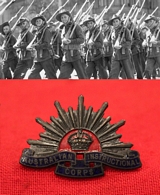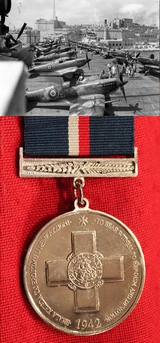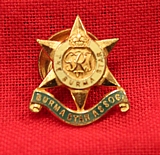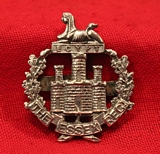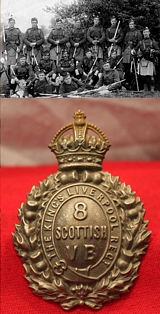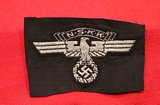WW1 / WW2 / 20th Century
A German WW2 Kriegsmarine Coastal Artillery BeVo Breast Eagle
Green ground with yellow eagle. A nice original Kriegsmarine yellow example. Coastal artillery was the responsibility of the Kriegsmarine, and most of the weapons employed in this manner were captured or obsolete weapons, their role was a defence against invasion, rather than proper coast defence against naval attack many of these guns were mounted in defensive works of either turrets or casemates. Marine Artillery Units were trained as ground artillery. There are several accounts of Naval Artillery Forward Observers during the Market Garden operation. Coastal batteries were used against ground targets all the way up the French coast, that is, if they could be turned towards the landward side.
Also, something to keep in mind, Naval Artillerymen are trained to hit moving targets such as ships, not much of a stretch to hit relatively stationary ground targets and the like such as a battalion area or a road junction. Coordinates, angles, grids, and trajectories are calculated much the same and a big shell is a big shell regardless of the target? read more
65.00 GBP
WW2 Australian Instructional Corps - Officer Bronze and Enamel Hat Badge
A mighty rare badge of WW2. Australian Instructional Corps - Officer Bronze and Enamel Hat Badge 1921 - 55. Worn from 1930 to 1942.
The Australian Instructional Corps (AIC) was the permanent force posting unit for the Warrant Officer Instructors of the Australian Army from 1921 to 1955. Complete with two lugs.
A highly desirable hat badge. These were worn by Warrant Officer trainers who were responsible for the training of the Militia Battalions and Regiments (Citizen Military Forces) from 1921 to 1942 and the Volunteer Defence Force (VDF) from 1942 to 1945 as well as the 2nd AIF post 1939.
The AIC ran qualification courses for militia and AIF officers and NCOs at specialist schools across the country.
Many of the instructors were commissioned as Officers or were employed as senior NCO's in these war time formations.
The AIC reached its peak in 1942 with 234 quartermasters and 889 warrant officers so both types of these insignia can be quite hard to come by read more
245.00 GBP
Malta's British Empire 'George Cross' for Heroism Commemorative Medal
Available to veterans who served in Malta between the dates of 10th June 1940 and 8th September 1943 to be worn with pride not alongside gallantry decorations, but separately and distinctively.
In April of 1942 King George VI in a dramatic and unprecedented gesture conferred the George Cross medal on the tiny Mediterranean island of Malta.
As it transpired April was the final month of the great Luftwaffe offensive and possibly the most difficult period of the siege so devastatingly enforced by the Axis powers. The island and its population had been subjected to a constant and unrelenting bombardment since June 1940 and were not to experience any relief from these conditions until the final months of 1942 when supplies and aid began to reach the defenders in significant quantities.
All over the world the people of the United Nations had followed the resistance of the islanders and those trying to bring aid by sea and air. The news of the award of the George Cross was internationally welcomed as it served in a tangible way to mark the heroism of all concerned.
The Government of Malta dignified the fiftieth anniversary of the presentation of the George Cross to the island in 1942 by striking the 'Malta George Cross Fiftieth Anniversary Commemorative Medal'. The closing date for application was 15th April 1994.
Next of kin could also apply for the medal which would only have been issued on receipt of a completed application form and proof of service in Malta between the dates of 10th June 1940 and 8th September 1943.
The colours of the ribbon, two narrow stripes of white and red on a background of blue, are representative of the Malta flag and the George Cross. read more
95.00 GBP
WW2 Burma Star Association Lapel Badge
The Burma Star Association was officially founded on the 26 February 1951 with 2,000 founder members. The badge of the Association incorporates a replica of the Burma Campaign Star. Permission to take advantage of this singular honour was supported by His Majesty King George VI in consultation with Earl Mountbatten and Field Marshal Viscount Slim and the badge and title were accepted by the College of Heralds. This fact recognises the rigorous nature of climate, topography and the extremely debilitating conditions in which to wage a successful campaign against a determined and fanatical enemy, thus making this Association unique among post war ex-Service Associations.The first President of the Association was Field Marshal Viscount Slim (Uncle Bill) who held this position until his death on 14 December 1970. read more
15.00 GBP
A Pair of Franco Period Late1930's Spanish Nationalist Officers Epaulettes
On green wool cloth with gilt bullion. read more
95.00 GBP
A 1930's Essex Regt. Silver Officers Cap Badge
Essex Regiment Officer?s 1935 silver cap badge. Fine example. Within an oak wreath surmounted by a Sphinx resting on ?Egypt? tablet Castle and Key of Gibraltar, across the base a scroll inscribed ?The Essex Regt?. The Essex Regiment was a line infantry regiment of the British Army in existence from 1881 to 1958, and served in many conflicts such as the Second Boer War and both World War I and World War II, serving with distinction in all three. The regiment was formed in 1881 under the Childers Reforms by the amalgamation of the 44th (East Essex) Regiment of Foot and the 56th (West Essex) Regiment of Foot. read more
120.00 GBP
8th Scottish Volunteer Battalion Helmet Plate the Kings Liverpool Regiment,
The pre-war territorial Battalions of The King's Liverpool Regiment will also show that the social class within the city was still divided. The King'sLiverpool had six territorial battalions within the city, 5th, 6th, 7th, 8th, 9th, and 10th. The 6th catered for the middle class, 5th, 7th and 9th for the respectable working class, while 8th ( Irish ) and 10th ( Scottish ) recruited men with links to the respected country. the King's Liverpool territorial regiments fought alongside one another many times in France and Belgium in WW1. The battalion was formed on 30th April 1900 when due to the Boer War, it became clear there was a need for men to volunteer their service. It was raised from the higher educated and professional young Scotsmen of city of Liverpool and named the 8th (Scottish) Volunteer Battalion, The King's (Liverpool Regiment). To join you paid an annual subscription of 10 shillings, and an entrance fee of ?2. The first Commanding Officer was Colonel C. Forbes Bell. read more
75.00 GBP
A National Socialist Motor Corps Enlisted Man's Side Cap Eagle Badge
an eagle sitting, its talons gripping a wreath swastika below, with a ribbon banner above inscribed "NSKK", - read more
65.00 GBP



